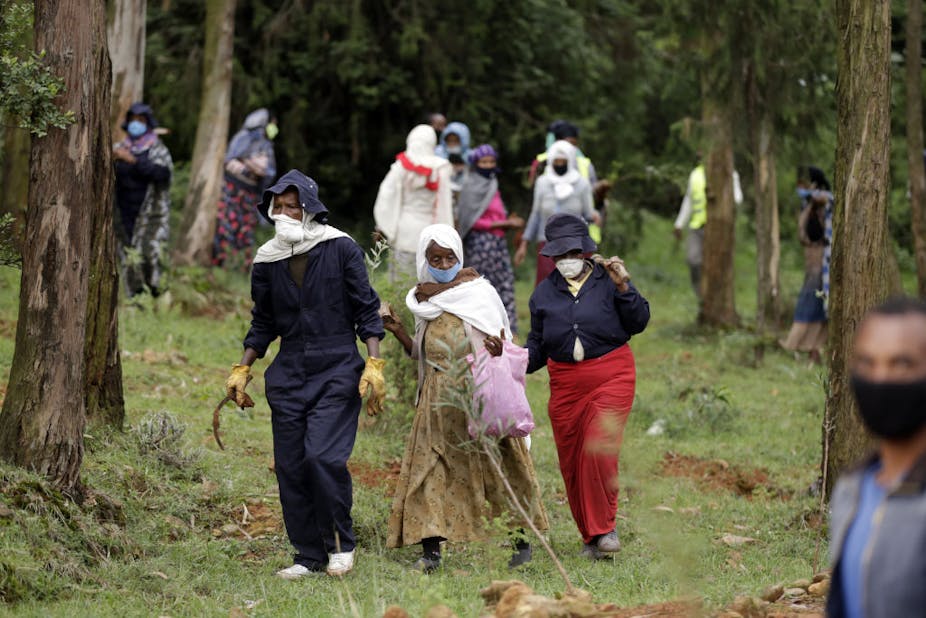Around the world, there are huge tree-planting initiatives happening. Their aim is to restore forest landscapes, as having more trees provides livelihood benefits, enhances biodiversity by providing a habitat for other organisms and otherwise protects the environment. Some initiatives seek to sequester carbon with the aim of mitigating climate change.
In Africa, for example, the purpose of the Great Green Wall initiative, which began in 2007, is to restore 100 million hectares of currently degraded land by 2030. The initiative depends both on the direct planting of trees (and other vegetation) and on assisting their natural regeneration.
At the global level, the target of the Bonn Challenge is to bring 350 million hectares of degraded and deforested landscapes into restoration through the same means by the same date.
A common problem though is that restoration projects have limited success in reaching their desired outcomes. For example, the trees planted often do not survive because they have been poorly chosen. Those that do are limited in their compositional range and therefore don’t much support the presence of other plants and animals, as noted in an assessment of the “Grain-for-Green” tree planting programme in China.
There are many reasons for the failure of massive tree-planting schemes. The one that we, as applied researchers in agroforestry, have sought to address is the insufficient attention given to the trees that need to be planted in terms of what should be grown where. This is of both the species that will be planted and the particular source of the seed that is used for any particular species. In addition, more attention is needed in terms of how the required tree seed and seedlings will be obtained, and delivered, to the planting sites.
The current situation is that non-native tree species end up being planted. These can, in popular terms, cause “ecological havoc” or, in other words, have unintended consequences that degrade the environment even further, sometimes rapidly. These unsuitable trees are usually used because the actual planters of the trees don’t have the knowledge on what would be better to plant, or simply don’t have access to the needed tree seeds.
The topic was taken up recently in a Science Feature by science journalist Rachel Cernansky. In her interviews with us and our colleagues, we explained the importance of doing “tree seed sourcing” –- a term we use to embrace the sourcing of both tree seed and seedlings –- better. Otherwise, the planters suffer initially and the broader restoration initiative loses out too in the end.
There are a number of ways to address this problem and improve outcomes. They all involve work to improve the availability of tree seed sources, networking and building the capacity of the different actors who are involved in seed supply, and sharing information on how to improve the current situation. Below, we share some of our insights.
Doing it right
Key to the success of mass tree-planting initiatives are having enough of the right seeds.
For instance, we at World Agroforestry (ICRAF) work with country partners – such as the Ethiopian Environment and Forest Research Institute and the Burkina Faso National Tree Seed Centre – to improve the current situation by putting in place “tree seed systems”. These are meant to ensure that the needed high-quality tree seed is collected from high quality sources, multiplied through seed orchards and nurseries, and made available to growers.
An African example is an initiative in Ethiopia known as the Provision of Adequate Tree Seed Portfolios project (PATSPO). This is supporting the country’s ambitious restoration target of 15 million hectares by 2030. The aim is to restore degraded lands and support livelihoods.
We are growing “breeding seedling orchards” of mostly indigenous timber and other native trees that will meet restoration needs with locally adapted seed. So far, 26 orchards have been established and more are to follow. Building on these, networks of public and private sector delivery partners are being enhanced and their capacity built, to improve the tree seed system infrastructure.
Our earlier analysis indicates that small- and medium-scale entrepreneurial suppliers of tree seed and seedlings have a particularly important role to play in linking with smallholder tree planters in ways that are cost-efficient for both the supplier and the planter. And so they need support through training and the right policies.
There’s an additional benefit in sourcing from these local suppliers as it supports rural business development.
Cases such as the Ethiopian one can be scaled for impact regionally and inter-continentally.
Sharing knowledge
Measures such as those outlined above help to deal with the thorny issue of tree seed availability, but knowledge availability is also a problem.
We therefore develop open access online decision support tools, such as the Global Tree Knowledge Platform. Released earlier this year, this helps project managers and growers to determine what trees to plant where for what purpose. The tools we have developed include training materials, databases, maps and smartphone apps. These resources cover hundreds of tree species.
We recently also created The Resources for Tree Planting Platform, an assembly of practical knowledge on how to go about sourcing good quality tree seeds, from their initial collection, through their multiplication, to their distribution and appropriate use.
The purpose of this platform is to encourage more effective tree planting that is especially focused on small-scale tropical growers. The platform provides over 200 individual resources and we encourage tree planters, tree project planners, and tree researchers, to explore and make use of them.
The importance of getting tree seed sourcing right can’t be overemphasised. Natural climate solutions could provide over one-third of the cost-effective climate mitigation needed between now and 2030 to keep planetary warming below 2°C, and at the same time provide for benefits to economies, for biodiversity and for human health. These benefits however rely on restoration being done successfully – and at the centre of this are the effective tree seed systems.

